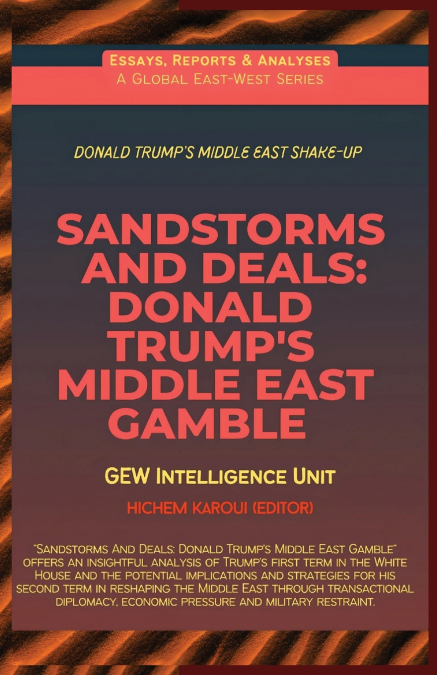
 Librería Perelló (Valencia)
Librería Perelló (Valencia)
 Librería Aciertas (Toledo)
Librería Aciertas (Toledo)
 Librería Elías (Asturias)
Librería Elías (Asturias)
 Donde los libros
Donde los libros
 El AlmaZen del Alquimista (Sevilla)
El AlmaZen del Alquimista (Sevilla)
 Librería Kolima (Madrid)
Librería Kolima (Madrid)
 Librería Proteo (Málaga)
Librería Proteo (Málaga)
'Sandstorms And Deals' explores the prospects for Donald Trump’s return to the White House, signalling a potentially dramatic shift in America’s approach to the Middle East. Building on his first administration’s legacy, Trump’s second term promises to reshape regional dynamics through transactional diplomacy, economic pressure, and military restraint. This book examines the likely trajectory of Trump’s Middle East policy based on his campaign promises, previous records, and early signals from his transition team. Trump’s first term was defined by several signature Middle East initiatives: withdrawing from the Iran nuclear deal, relocating the US embassy to Jerusalem, brokering the Abraham Accords between Israel and several Arab states, and reducing American military footprint in the region. His 'America First' doctrine prioritised immediate US interests over traditional alliance structures and multilateral frameworks. Trump appears poised to double down on these approaches in his second term. His campaign rhetoric suggests an accelerated expansion of the Abraham Accords, potentially bringing Saudi Arabia into formal relations with Israel. This normalisation push aligns with Trump’s preference for deal-making and could reshape regional security architecture around containing Iran. Regarding the Israeli-Palestinian conflict, Trump’s second administration is likely to continue its strong pro-Israel stance while pursuing what his team has termed 'peace through strength.' The administration may revive elements of the 'Deal of the Century' approach, emphasizing economic development for Palestinians while sidelining traditional diplomatic frameworks for statehood. On Iran, Trump has signalled a return to 'maximum pressure' sanctions and isolation strategies. His administration appears determined to block Iran’s nuclear ambitions and regional proxy activities permanently. This hardline approach may increase tensions and complicate diplomatic efforts by European allies, potentially leading to greater regional polarization. Trump’s energy policy will significantly impact the region. His promised focus on American energy dominance and increased domestic production could affect oil markets and US relationships with Gulf partners. These states may need to offer more substantial concessions-whether in arms purchases, normalization with Israel, or regional security commitments-to maintain close ties with Washington. A defining characteristic of Trump’s approach is transactional diplomacy. Regional allies may face increased pressure to demonstrate tangible value to American interests through arms purchases, counter-terrorism cooperation, or economic deals benefiting US businesses. The military strategy will reflect Trump’s scepticism of open-ended commitments. While maintaining counter-terrorism operations, the administration may further reduce conventional troop deployments, emphasising air power, special operations, and partner capacity-building. The second Trump administration entered the Middle East, which was transformed by the Gaza conflict, shifting economic priorities, and evolving great power competition with China and Russia. How Trump navigates these complexities will determine whether his approach brings greater stability or volatility to this critical region. For regional leaders and international stakeholders, understanding Trump’s decision-making framework-prioritising direct US interests, favouring bilateral deals over multilateral frameworks, and evaluating relationships through an economic lens-will be essential for navigating this new chapter in American Middle East policy.